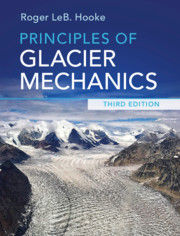Book contents
- Principles of Glacier Mechanics
- Reviews
- Principles of Glacier Mechanics
- Copyright page
- Dedication
- Contents
- Preface to the third edition
- Preface to the second edition
- Preface to the first edition
- Physical constants relevant to ice
- Derived SI units and conversion factors
- 1 Why study glaciers?
- 2 Some basic concepts
- 3 Mass balance
- 4 Flow and fracture of a crystalline material
- 5 The velocity field in a glacier
- 6 Temperature distribution in polar ice sheets
- 7 The coupling between a glacier and its bed
- 8 Water flow in and under glaciers: Geomorphic implications
- 9 Stress and deformation
- 10 Stress and velocity distribution in an idealized glacier
- 11 Numerical modeling
- 12 Applications of stress and deformation principles to classical problems
- 13 Ice streams and ice shelves
- 14 Finite strain and the origin of foliation
- 15 Response of glaciers to climate change
- 16 Ice core studies
- Problems
- References
- Index
10 - Stress and velocity distribution in an idealized glacier
Published online by Cambridge University Press: 20 December 2019
- Principles of Glacier Mechanics
- Reviews
- Principles of Glacier Mechanics
- Copyright page
- Dedication
- Contents
- Preface to the third edition
- Preface to the second edition
- Preface to the first edition
- Physical constants relevant to ice
- Derived SI units and conversion factors
- 1 Why study glaciers?
- 2 Some basic concepts
- 3 Mass balance
- 4 Flow and fracture of a crystalline material
- 5 The velocity field in a glacier
- 6 Temperature distribution in polar ice sheets
- 7 The coupling between a glacier and its bed
- 8 Water flow in and under glaciers: Geomorphic implications
- 9 Stress and deformation
- 10 Stress and velocity distribution in an idealized glacier
- 11 Numerical modeling
- 12 Applications of stress and deformation principles to classical problems
- 13 Ice streams and ice shelves
- 14 Finite strain and the origin of foliation
- 15 Response of glaciers to climate change
- 16 Ice core studies
- Problems
- References
- Index
Summary
In this chapter, the equations developed in Chapter 9 are used to solve for the stress and velocity distribution in an idealized “glacier” consisting of a slab of ice of infinite extent on a uniform slope. Solutions are first obtained for ice with a perfectly plastic rheology.Both the shear stress and the surface-normal stress increase linearly with depth. The shear stress equals the plastic yield stress at the bed. Longitudinal normal stresses vary non-linearly, and are compressive in the ablation area and extending in the accumulation area.The surface-normal velocity also varies linearly with depth. The surface-parallel velocity varies non-linearly, with a high gradient near the bed. The stress solutions and the solution for the surface-normal velocity are essentially the same in a non-linear material, except that the shear stress does not reach a limiting value at the bed.However, the surface-parallel velocity, while varying with depth in a similar way, is now dependent on the longitudinal strain rate, and the solution is much more complicated. Interestingly, however, it does not matter whether the longitudinal strain rate is compressive or extending.
Information
- Type
- Chapter
- Information
- Principles of Glacier Mechanics , pp. 274 - 290Publisher: Cambridge University PressPrint publication year: 2019
